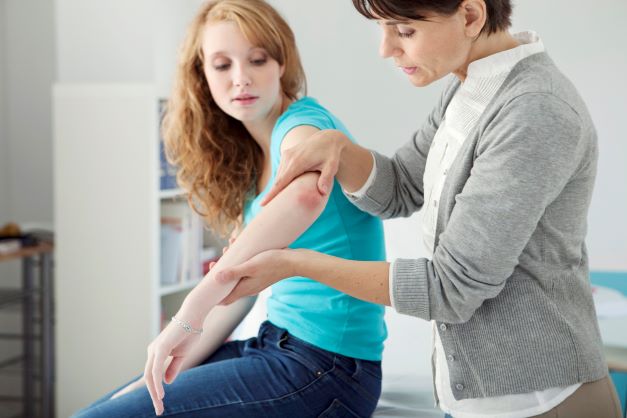Psoriasis is a chronic skin condition that impacts more than seven million people of all ages in the U.S. each year. According to the American Academy of Dermatology, the majority of people with psoriasis have mild to moderate cases, but about 20% experience moderate to severe cases, which can be debilitating. Learning psoriasis triggers is one of the main ways people can prevent or manage psoriasis flare-ups. According to Dr. Megan Lent of U.S. Dermatology Partners in Chillicothe, Missouri, “No two people will have the exact same psoriasis triggers, but when patients take the time to identify theirs, they can significantly minimize the number and severity of psoriasis flare-ups for increased comfort and dramatically improved skin health.” In this blog, Dr. Lent talks about how to identify common psoriasis triggers and how learning psoriasis triggers can keep skin healthier.
What Is Psoriasis?
Psoriasis is a term used to refer to several related autoimmune and skin conditions that cause reactions that impact skin health. Specifically, psoriasis causes immune system overreactions that lead to symptoms like thickening of the skin, joint pain, inflammation, and other symptoms related to increased immune response. There are several different types of psoriasis, and each one has its own set of symptoms and treatment options. While there are many different types of psoriasis, most people will develop one of the five most common forms of psoriasis:
- Plaque psoriasis – This is the condition most people think of when they hear the word psoriasis. This form of psoriasis creates thickened patches of skin called plaques that may look red with silvery dry or peeling areas of skin. These plaques can develop anywhere, but they’re most common on the elbows, knees, scalp, or back.
- Pustular psoriasis – This form of psoriasis impacts the hands and feet. It usually looks like red areas of skin dotted with white blisters or pustules.
- Guttate psoriasis – This form of psoriasis often develops in young people who have streptococcus infections, but it can impact people of all ages. When developed by young people, there is a chance for guttate psoriasis to completely clear up by the time they reach adulthood without recurrence. The impacted skin may resemble a rash with small red bumps.
- Inverse psoriasis – This form commonly affects folds of skin like the armpits, bends of elbows and knees, and the groin and buttocks. Symptoms typically look like smooth and shiny red lesions.
- Erythrodermic psoriasis – This is the most severe form of psoriasis. Erythrodermic psoriasis flare-ups typically impact large areas of the body and require immediate medical intervention.
In addition to these forms of psoriasis, other types include nail and scalp psoriasis, which impact those specific areas of the body. You may also hear about psoriatic arthritis, a unique form of arthritis that affects the joint health of people who struggle with psoriasis. Apart from some children who grow out of guttate psoriasis, there is no cure for this skin condition, and the majority of people will live with and manage psoriasis symptoms throughout their lives.
Who Is at Risk for Psoriasis?
When it comes to risk factors for psoriasis, Dr. Lent says, “Psoriasis is one of the chronic skin conditions that impacts men and women in equal measure, and it can develop for anyone at any age from infancy to adulthood. People who have one or more family members with psoriasis are more likely to develop this condition, but almost anyone can develop psoriasis.”
What Are the Most Common Psoriasis Triggers?
According to Dr. Lent, “Everyone will have different psoriasis triggers. Unfortunately, this can make it difficult to pinpoint the exact triggers people should avoid in order to minimize the risk of psoriasis flare-ups. Keeping a log detailing skin health and psoriasis symptoms as well as any activities or engagement with potential triggers is one of the first treatment and prevention steps dermatologists will recommend for people to minimize the risk for psoriasis flare-ups. These logs can help patients understand their individual psoriasis flare-up triggers, so they can make changes to avoid or minimize exposure to these triggers.”
While each person’s triggers vary, some of the common psoriasis triggers include:
- Stress – psoriasis is an inflammatory skin condition. Stress increases cortisol levels, which can cause inflammation and trigger psoriasis flare-ups.
- Illness and infection – Because psoriasis is closely linked to immune function, anything that impacts immune health, including illnesses and infections, can trigger a psoriasis flare-up. Specifically, guttate psoriasis flare-ups tend to be linked to streptococcus infections (strep throat).
- Medications – Lithium, beta-blockers, and anti-malarial drugs have all been linked to increased risk for psoriasis flare-ups.
- Skin damage – Bug bites, cuts, bruises, burns, flare-ups in other skin conditions, or intentional skin injuries like tattoos, piercings, or surgeries can trigger a psoriasis flare-up. When psoriatic skin is injured, it can overreact, leading to inflammation, thickened skin, and other psoriasis symptoms.
- Weather – Cold, dry weather can trigger a psoriasis flare-up, especially when coupled with the drying effects of indoor heating.
- Hormonal shifts – Changes in hormone levels during puberty, pregnancy, and other periods of hormonal fluctuation have often been linked to psoriasis flare-ups.
Can Psoriasis Be Prevented?
According to Dr. Lent, “Taking the time to identify your psoriasis triggers is a great first step toward preventing flare-ups. There are other steps individuals can take to minimize the risk of a psoriasis flare-up, including reducing stress, eating a healthy diet, staying hydrated, exercising regularly, and getting plenty of sleep. Additionally, it’s important to reduce the risk of infection by avoiding people who are sick and treating wounds, burns, and other injuries as soon as they appear. You can also work with a physician to take steps to boost your immune function, reduce stress, treat high blood pressure, and otherwise stay healthy.”
Visit with a Trusted Dermatologist
If you’re interested in learning more about managing psoriasis, reducing the risk of flare-ups, or treating other skin health concerns, the U.S. Dermatology Partners team is here to help. We make getting started with our team simple. You can complete an online scheduling request from the comfort of home at any time. Once our local team members receive your request, they’ll be in touch to finalize the details of your visit.
Find a location near me
or


